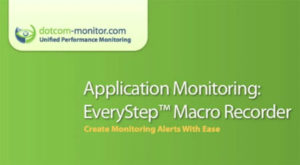
The Internet Backbone for Noobs – Infographic
Deep within the very heart of your body, lurks a force so intrusive and so powerful that it would terrify you if you came face to face with it. Your backbone – which is, in fact, many bones that together hold your skeleton and the rest of your body together.
The Internet also has a backbone. And just like your backbone, the Internet backbone holds the Internet together – a network of high capacity communications routes linking local Internet networks (comprising over 35 million Internet server sites) across land and under the sea. Here is a quick look at the Internet backbone.
Monitoring the Double Rainbow | Streaming Media Monitoring Tools
The Double Rainbow video guy is shilling for Microsoft and the stats on online videos continue on a sky rocketing uptick. Thus spoketh Double Rainbow guy “It’s so beautiful, but what does it mean?” It means that the ying of online video is in a gigantic, exuberantly crazy growth phase and that the yang of streaming media monitoring is nearby.

Server Room Cabling Hell: 13 of the Worst Server Wiring Jobs Ever!
It’s pretty sweet when you don’t have to worry about your servers. But while Dotcom-Monitor is monitoring your servers remotely for everything from speed to temperature, some poor system admins or IT techs are being dropped into a tangled nightmare. Here are 15 of the worst server wiring jobs ever, or in other words, welcome to Server Room Cable Hell.
The 4 Principles of Building Website Trust | Website Uptime Button
One of the key principles involved in creating a successful website is establishing trust with users. These four key principles demonstrate how a unique, third-party website uptime validation tool helps to create trust with online users.
Website Monitoring, Waterfall Charts, & Webpages of the Lycra-clad
An icon in the Twin Cities triathlon community, Jerry Bous, has a website problem that’s good to have. He has been able to parlay his love for the sport of triathlon into an occupation as THE triathlon race announcer as well as owner of the very popular and respected website www.MinnesotaTriNews.com.
But, the problem — similar to a triathlete who plateaus in their swim/bike/run speed at this point in the racing season — is that Jerry’s website may have recently “plateaued” in response time and in order to continue to improve is likely in need of some ongoing response time and performance monitoring.

Video: Application Monitoring with the EveryStep Macro Recorder
In this Application Monitoring Video we demonstrate the EveryStep Macro Recorder and use it to create Devices for monitoring websites and web applications.
Video: Alerts Configuration for Monitoring Devices
Download the video now. (45260 KB) This video provides a quick overview in how to get Alerts configured. If you’re curious how Filters, Schedules, and Groups all work together to help
Video: Platform Overview and Introduction to Devices
Download now: DM-Devices_Overview.mov (31476 KB) In this video screen-cast, we log in to the Dotcom-Monitor Member’s site to look at the list of Platforms and Devices to finally create a
Video: Configuration Options for Monitoring Devices
Download now: Dotcom-Monitor_Configuration_Options_for_Devices.m4v (41166 KB)
Video: Monitoring Devices Overview
Update: a new version of this video is available here. Download now:Dotcom-Monitor_Devices_Overview.m4v (26040 KB)
Video: Dotcom-Monitor Services Overview
Download now: Dotcom-Monitor Overview.m4v (14960 KB)
IRCE: Online Retail – Monitoring the Cost of Things Great and Small
As many of the online retailers we spoke with at Internet Retailer Conference & Exhibition (IRCE) noted, putting together all of the pieces for a successful online presence is difficult. Many of the online retailers at the show were at IRCE to out-source pieces of their business since it is more effective and cost-effective to do so. In many cases. Dotcom-Monitor’s suite of Application monitoring, website monitoring, and other network monitoring tools make it easier for the online retailer s to focus on what they’re best at – serving customers.

